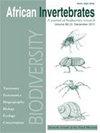Checklist, endemism, English vernacular names and identification of the cicadas (Insecta, Hemiptera, Cicadidae) of KwaZulu-Natal, South Africa
IF 1.1
4区 农林科学
Q3 ENTOMOLOGY
引用次数: 2
Abstract
Public understanding of the goals of applied biology and conservation is promoted by showcasing charismatic or significant organisms using vernacular names. Conservation activities in the province of KwaZulu-Natal, South Africa, are prioritising taxa that have high rates of provincial endemism, such as snails, earthworms, millipedes and cicadas. To assist wider public engagement in these activities, an assessment of endemism of the cicadas of KwaZulu-Natal is presented along with a dichotomous, 37-couplet key for the identification of males, based mainly on externally visible morphology and colouration. Standardised English vernacular names coined following a simple naming convention are proposed. Forty-two percent (16 out of 38) of the cicada species known from KwaZulu-Natal are endemic to the province. Photographs of some of the species are included to facilitate their identification. Photographs can be used for identification of various species providing that the diagnostic characters are visible in the photographs. For this purpose, photographs may have to be taken of hand-held individuals. Some of the endemic species are of particular concern for conservation because they are not known to occur in statutory protected areas or are only known from relatively small protected areas. The latter may not be able to ensure the long-term survival of the species. The rate and extent of loss of habitat outside protected areas is likely to be a grave threat to species that are not protected or that are inadequately conserved in statutory protected areas. The standardised vernacular names proposed here provide a tool for communicating provincial conservation plans and concerns with stakeholders in KwaZulu-Natal and for stimulating interest in cicadas amongst land users, environmental impact assessment practitioners, biologists, naturalists and citizen scientists.南非夸祖鲁-纳塔尔省蝉类(昆虫纲、半翅目、蝉科)的清单、特有种、英文地名和鉴定
公众对应用生物学和保护目标的理解是通过使用当地名称展示有魅力或重要的生物体来促进的。南非夸祖鲁-纳塔尔省的保护活动正在优先考虑具有高省级特有性的分类群,如蜗牛、蚯蚓、千足虫和蝉。为了帮助更广泛的公众参与这些活动,对夸祖鲁-纳塔尔蝉的地方性进行了评估,并提供了一个主要基于外部可见形态和颜色的用于识别雄性的二分37联钥匙。根据一个简单的命名惯例,提出了标准化的英语白话名称。夸祖鲁-纳塔尔已知的知了物种中,42%(38种中的16种)是该省的特有物种。其中包括一些物种的照片,以便于识别。只要诊断特征在照片中可见,照片可用于识别各种物种。为此,可能必须拍摄手持个人的照片。一些特有物种特别值得保护,因为它们不存在于法定保护区,或者只存在于相对较小的保护区。后者可能无法确保该物种的长期生存。保护区外栖息地的丧失速度和程度可能会对未受保护或在法定保护区内保护不足的物种构成严重威胁。这里提出的标准化地名为与夸祖鲁-纳塔尔省的利益相关者交流省级保护计划和关注提供了一种工具,并激发了土地使用者、环境影响评估从业者、生物学家、博物学家和公民科学家对蝉的兴趣。
本文章由计算机程序翻译,如有差异,请以英文原文为准。
求助全文
约1分钟内获得全文
求助全文
来源期刊

African Invertebrates
生物-动物学
CiteScore
1.00
自引率
0.00%
发文量
6
审稿时长
>12 weeks
期刊介绍:
African Invertebrates is an international peer-reviewed, open-access journal that focuses primarily on the taxonomy, systematics, biogeography, and palaeontology of Afrotropical invertebrates, whether terrestrial, freshwater or marine. Aspects concerning biology, ecology, and conservation may also be considered where these relate to the primary focus areas. Papers dealing solely with biology, ecology, physiology, pests and pest control should be submitted elsewhere.
 求助内容:
求助内容: 应助结果提醒方式:
应助结果提醒方式:


